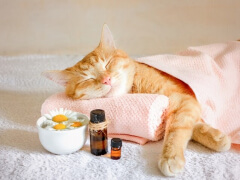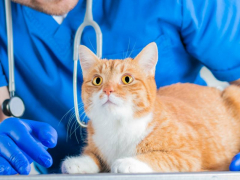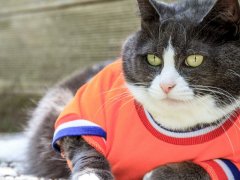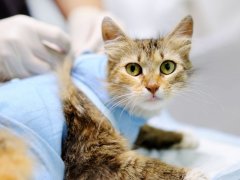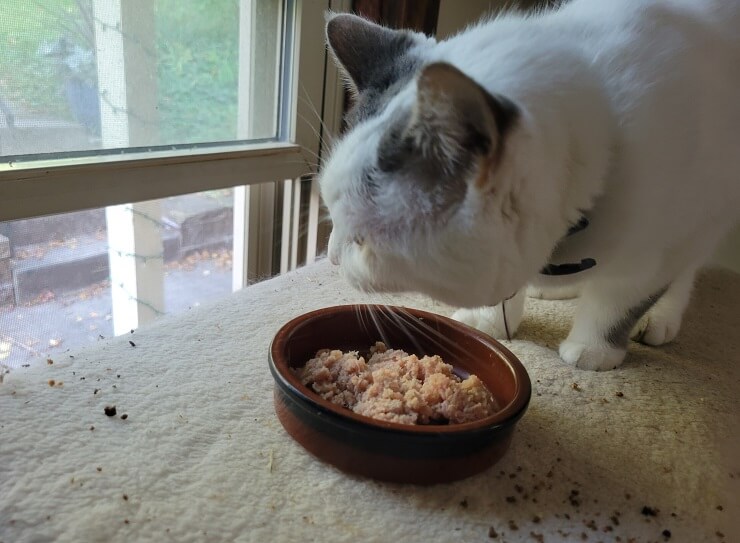
Kate Barrington / Cats.com
As with all carers of animals, one of the basic questions that we need to answer every day for our cats is: “how much should I feed my cat?”
This article will help you discover how much food you should be feeding, so that you can ensure that your cat stays at their optimal body weight.
Firstly, What Type of Food Should Cats Eat?
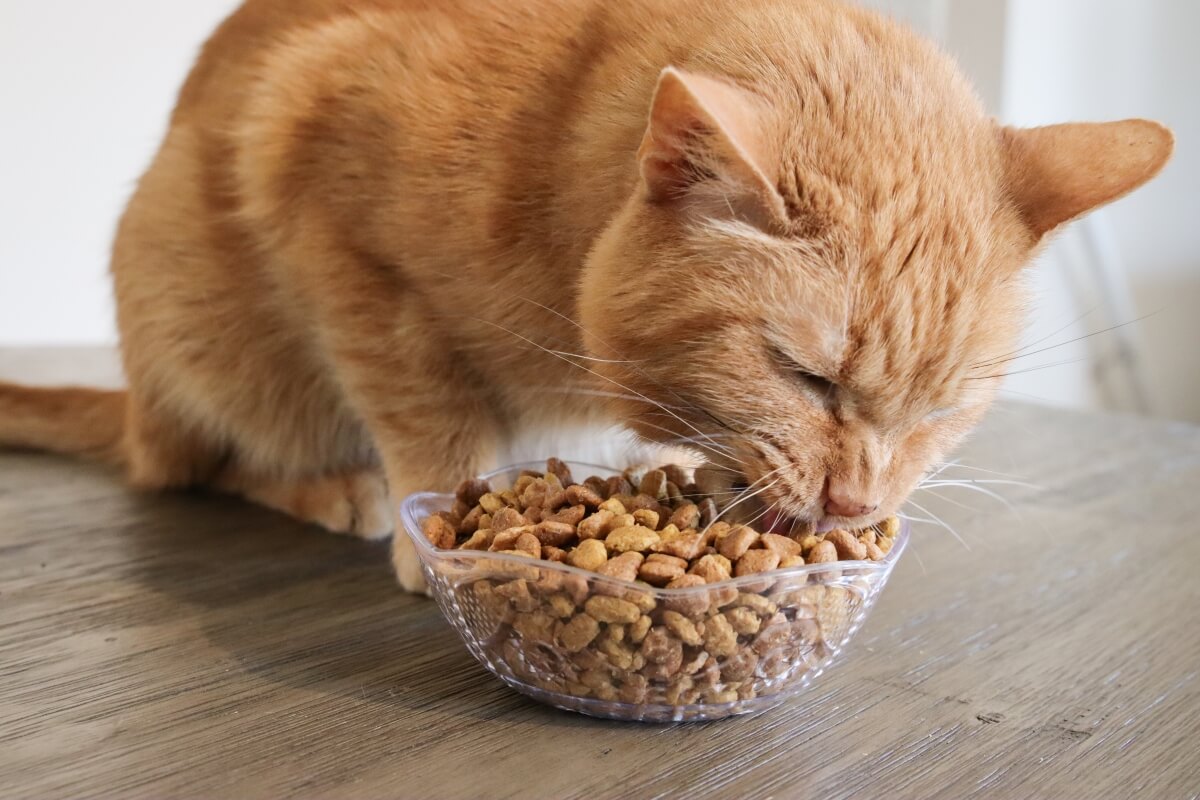
It’s critical to feed your cat a nutritionally complete and balanced diet that contains all of the nutrients your cat needs to thrive. Kirsten McCarthy / cats.com
You can meet a healthy cat’s nutritional needs met by feeding the right amount of the right type of food every day. This diet should give your cat the correct quantities of carbohydrates, fats, minerals, vitamins and proteins/ amino acids, including essential nutrients like taurine.
The easiest way to do this is to use a nutritionally balanced complete commercial pet food, whether wet cat food (canned cat food) or dry cat food (kibble) or a mixture of the two types.
Good quality food should be fed in the right quantities, with other aspects (like grain-free or specific ingredients) being far less important than many owners may believe.
Cat treats can also be offered, in limited quantities. Fresh water, of course, is calorie-free and should always be available to cats. A cat’s litter box should be monitored by cat carers. Normal feces is an important guide to the suitability of a diet to an individual cat.
The daily food offered to a cat is an important contributor to their overall health.
Why Is It So Common for Cats To Become Overweight or Obese?
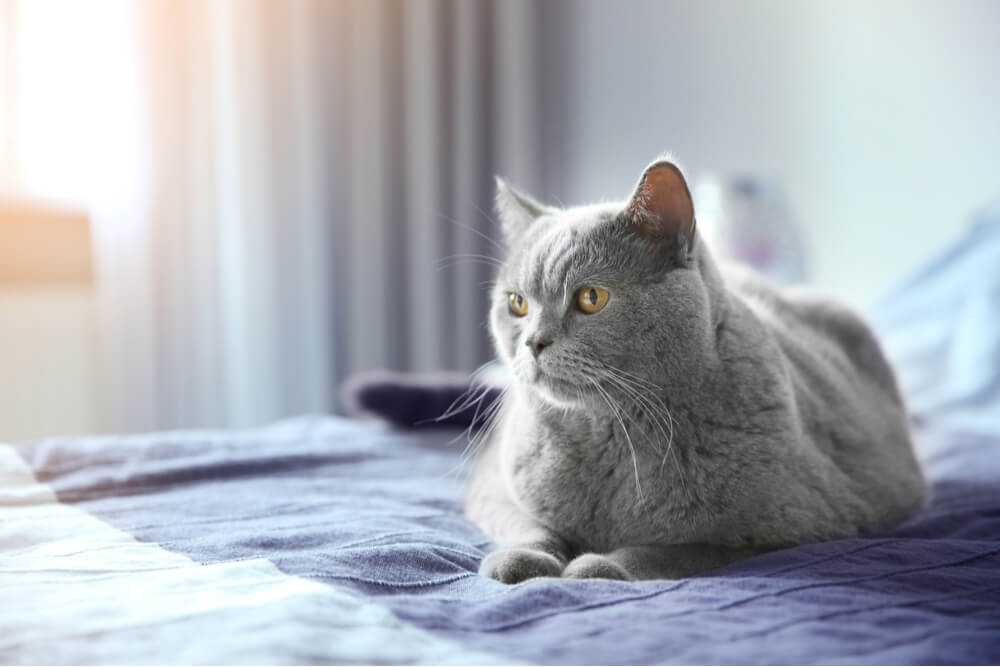
An estimated 50% of cats over the age of five carry too much bodyweight, making them either overweight or obese. Too much food is the main contributor to excessive bodyweight, so it’s essential to make sure your cat is eating the right amount.
It has become increasingly common for pet cats to become overweight or obese, with estimates that around 50% of cats over the age of five years carry too much body weight. Cat carers are often not aware that their pets are overweight or obese, yet an overweight cat is more likely to suffer health issues such as diabetes, heart disease, arthritis, kidney disease, and a shorter life span.
The most common reason for cats becoming overweight or obese is simply that cat carers offer their cat more food than their cat needs.
That’s why it’s so important to know how much food you should offer your cat every day, so that your cat avoids preventable health problems later in life.
Cats, just like humans, enjoy eating: it’s one of the great pleasures of life, and a cat’s diet is one of the most important parts of their day. And because cat carers like to make their pets happy, it’s all too easy to want to give them extra food, to give them even more enjoyment in life.
Also Read: The 10 Best Cat Foods
However, we all need to step back and recognise that while feeding a pet makes them happy in the immediate moment, if we give them too much food, the excessive food intake causes serious discomfort, poor health, and a shorter life in the long term.
So if we genuinely care about helping them achieve their best possible lives, we should be disciplined about how much food we feed them so that they stay at a healthy weight.
What Sort of System Should I Use for Feeding My Cat?
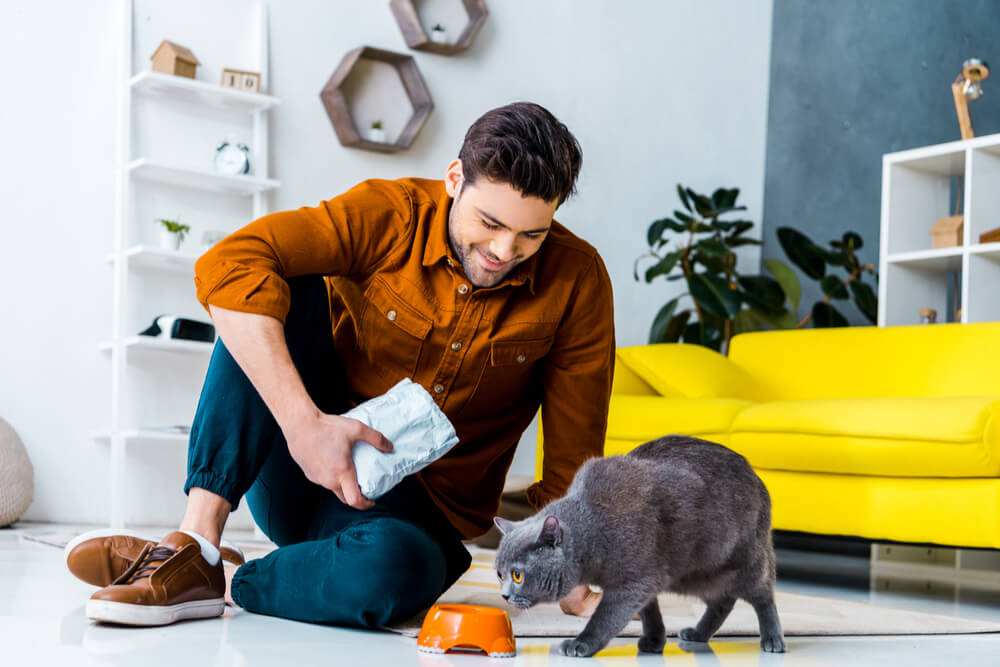
The way you feed your cat can be almost as important as how much you feed them.
In the past, many people have given their cats free choice , free-feeding, or ad libitum i.e. offering them as much in their food bowl as they wish to eat. In particular, a bowl of dry food (kibble) has often been continually topped up, allowing the cat to eat this whenever they wish to do so.
It is now recognised that feeding cats using this method is likely to lead to cats eating too much, leading them to be overweight or obese. Instead, cat carers should calculate the correct daily amount to feed, and either weigh this amount daily, or use a feeding container to give the measured amount every day as their cat’s food supply.
Whichever method is used to calculate how much a cat should be fed, it is impossible to generalize for every individual cat, because of several variables that are not the same between different animals.
The first three variables can be factored into calculations:
- Age: growing animals need more food, and the precise quantity varies depending on how fast that cat is growing. Meanwhile, older cats (senior cats) tend to be less active, with reduced energy needs.
- Size: larger animals have higher daily energy needs compared to smaller animals.
- Neutered status: if a cat has been spayed or neutered, then they generally have lower energy needs than entire animals.Other significant variables between animals that are more difficult to specify include:
- Activity level: outdoor cats spend more time moving than indoor cats, so they need more energy. As well as this broad difference, individual cats, whether indoor or outdoor, have different levels of activity that can be hard to monitor or calculate.
- Metabolic rate: some individual cats have a faster resting metabolic rate than other cats, meaning that they need more food than others to supply their basic energy needs every day. Again, this is not something that can be easily calculated by owners.
Here’s How To Start To Work Out How Much To Feed.
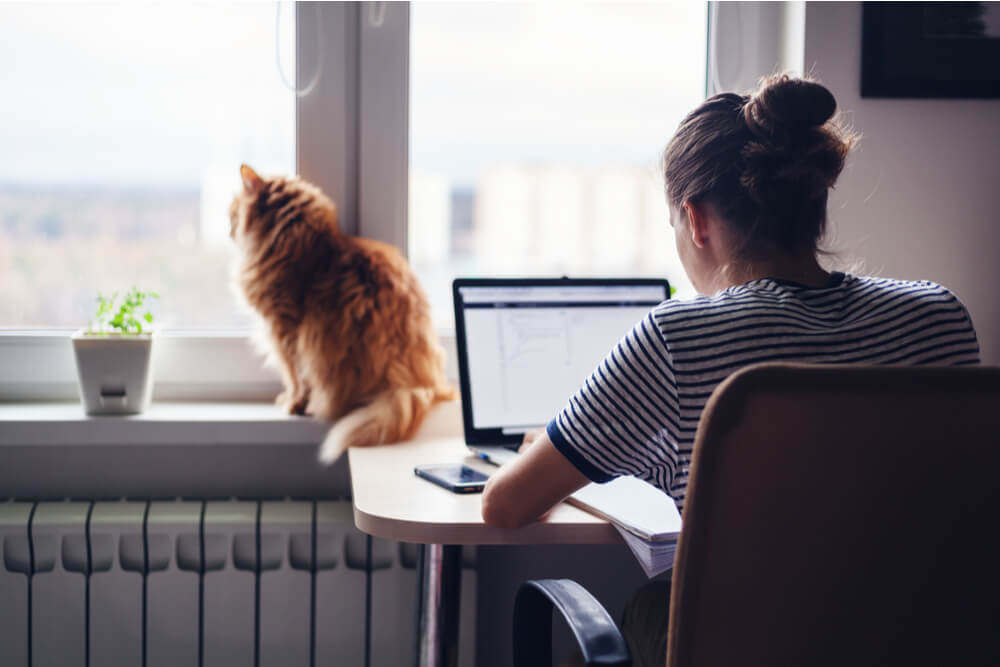
Several factors go into determining how much your cat needs to eat.
The starting point is to establish five facts about your cat.
- How old are they?
- How much do they weigh currently?
- Are they neutered or entire?
- Are they active (e.g. outdoor) or inactive (e.g. indoor)?
- Are they currently the correct weight, are they underweight, or overweight? Please read our article on body condition score to discover this important fact about your own cat.These five facts are used to help to work out how much to feed, using one of several different possible methods.You also need to note what type of food you are using, and get a notebook to record how much food you feed every day, recording the number of sachets of most food (or tins of canned food), and the weight, in grams, of dry cat food.
You Can Also Calculate How Much To Feed Your Cat by Reading the Label
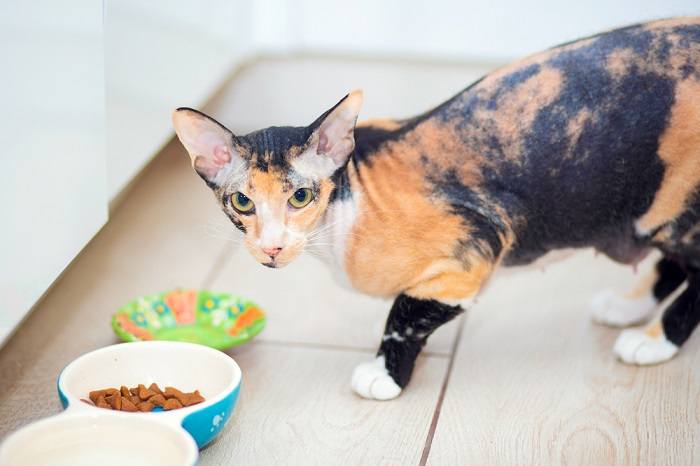
Cats, just like humans, enjoy eating: it’s one of the great pleasures of life, and a cat’s diet is one of the most important parts of their day.
Most commercial pet foods include a guide to feeding quantities on the label of the packaging. Typically there is a chart, with the cat’s weight in the left column, and the recommended amount of food in the right column e.g 8.8lbs (4kg) and 2.3 ounces (65g) for dry food, or 8.8lbs (4kg) and 2 sachets or pouches for wet food, or a mixture, such as 1 ounce (28g) dry food plus one sachet of wet food.
Some people prefer to work with volumes (e.g. cups) rather than absolute weights, but the challenge is that dry food varies in density, so it’s better to work with weight on the first occasion, but place the volume of food in the container of your choice (e.g. a plastic cup) and draw a line with a permanent marker so that you can see how much volume this makes. Then on future occasions, you can simply use the plastic cup, up to your line, as a daily guide.
Sometimes there are different recommendations for active (outdoor) and inactive (indoor) cats, neutered or entire cats, and for cats that are obese, overweight, or at their correct body weight.
These recommended amounts represent the manufacturer’s calculation of the correct amount of daily food for an average cat.
Often, a range of recommended quantities is given, rather than a single specified amount. This is recognition of the fact that it is impossible to say precisely how much any individual cat should be fed: there is always variation based on a number of factors.
There is an untrue myth that pet food manufacturers deliberately overstate the recommended feeding amounts on the label in an attempt to make people use more pet food. In fact, the recommended feeding amounts do represent a reasonable estimate that is useful for many cat owners who may not be able to calculate correct feeding quantities using other methods.
How Much To Feed a Cat by Age?
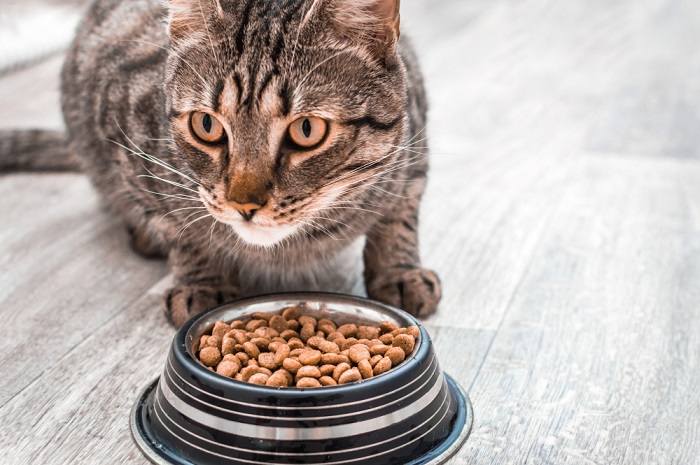
There is an untrue myth that pet food manufacturers deliberately overstate the recommended feeding amounts on the label in an attempt to make people use more pet food.
Growing kittens need comparatively more food than adult cats, because they need nutrients to allow their body to grow. This can be difficult to calculate precisely, and professional veterinary nutritionists have charts and guides that may be applied.
For most cat carers, it is simpler to recognise that kittens do have higher requirements, and that it is rare for kittens to become overweight or obese. Using the broad guidelines on the packaging, it is fairly safe to say that kittens can be fed almost as much food as they wish to eat at each mealtime, within reasonable limits.
- If the kitten is still chasing the bowl, looking for more food when they have finished, they should be offered a little more.
- If the kitten routinely does not finish the food that is offered in the bowl, they should be offered less the next time.
How Much To Feed a Cat by Weight?
Once a cat has passed kittenhood, and has stopped growing, it is possible to work out how much to feed based on their body weight. The recommended daily caloric intake can be calculated using a formula to work out the resting energy requirement (RER):
RER=70 x (body weight in kg/lbs) to the power of 0.75 or 70 x (weight in kg/lbs ^ 0.75)
To work out the “to the power of 0.75” part of the equation, you can either use a calculator that allow you to use exponents, or you can multiply the weight in kilograms by itself 3 times (e.g. 4x4x4 for a 4kg/8.8lbs cat), then work out the square root of that sum, twice.
This calculation will give you the resting energy requirement for your cat in kilocalories. You then need to multiply this by a different factor depending on your individual cat to estimate their total daily energy needs, with possible variables listed below.
How Much To Feed a Cat Chart
| Neutered adult cat | 1.6 x RER |
| Entire adult cat | 1.8 x RER |
| Inactive adult cat | 1.2-1.4 x RER |
| Cat aiming to lose weight | 1.0 x RER for ideal weight |
| Cat trying to gain weight | 1.2-1.8 x RER for ideal weight |
| Very active outdoor cat | 2.0-4.0 x RER |
How Much Food To Feed a Cat Calculator
You can use our simple calculator to easily determine how much to feed your cat without worrying about complicated formulas.
You should remember that an individual cat’s needs may vary by as much as 50% from these calculated values, and that it is always necessary to modify feeding quantities depending on how a cat’s body weight changes over time.
Once the daily recommended number of kilocalories has been calculated, you then need to discover how many kilocalories are in the food that you are offering. This depends on the ingredients in the food. You can usually discover this, if not on the food label, by visiting the pet food manufacturer’s website, or by contacting them directly.
This method will allow you to calculate for yourself, from first principles, approximately how much food you should be feeding your cat.
For many people, this type of calculation is too complex, and they prefer to simply follow the manufacturer’s guide on the label, modifying this over time depending on how their pet’s body weight changes.
Cat Feeding Schedule
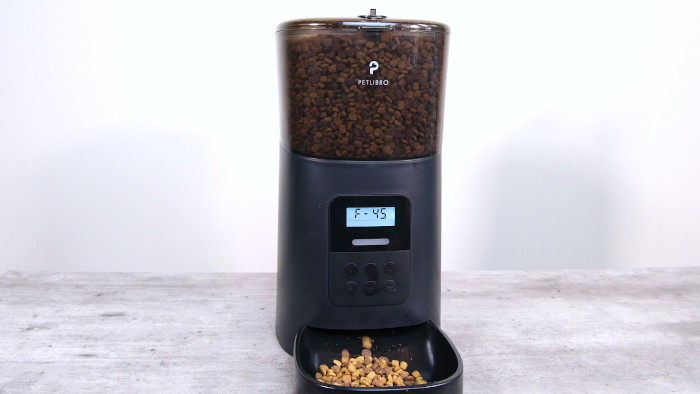
Kate Barrington / Cats.com
Cats in the wild are hunting carnivores, consuming small meals frequently as they catch small prey throughout the day. Ideally, a feeding regime at home should follow the same pattern, with smaller meals being offered more frequently, e.g. four times daily.
Also Read: The Complete Feeding Guide From Kittens To Seniors
Many people, for reasons of convenience, feed their cats less often, but the frequency should never be less than twice daily e.g. morning and evening.
Conclusion
The exact quantity of food fed every day is an important variable to ensure long term feline health. It’s important to record how much food is fed every day, and to monitor your cat’s body condition every month. Weight gain, or weight loss, can then be monitored. If your cat starts to become overweight, you need to feed less food every day, and if they start to become underweight, you need to offer more food every day.
Ideally, you should weigh your cat every month to monitor how their body weight changes: you can do this using electronic scales (e.g. at your local veterinarian’s office) or you can stand on your own bathroom scales holding your cat, then weigh yourself afterwards to work out the difference.
